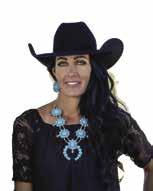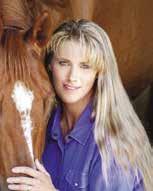


















Vol. 32 No.4
WIINTER WESTERN HORSE REVIEW
EDITORIAL
editorial@westernhorsereview.com
Publishers
Clay & Jenn Webster
Editor
Jenn Webster
Art Direction and Production
Kendra Roberts
Advertising advertising@westernhorsereview.com
Marketing & Account Executives
Laurie Price ldprice63@gmail.com
Subscriptions
$19.95 CDN - 1 year Subscription
$39.95 USD - 1 year Subscription
For SUBSCRIPTION ENQUIRIES: 1-855-464-4523 or subscriptions@westernhorsereview.com
For BACK ISSUES visit our Store at www.westernhorsereview.com
Subscribers: Your name may be made available to reputable companies with products that may interest you. If you do not want your name shared, please e-mail subscriptions@westernhorsereview.com and request OPT-OUT in the subject line.
Accounting
Laurie Price at (403) 250-1128 ldprice63@gmail.com
Contributors
BAR XP Photo
Alex Callaghan Photography
Ryan Fleetwood, Tim Hiller
Leah Leduc Photography
Debbie MacRae, Chet Martin
Primo Morales ,Aidan Nicholson
Mike Nicola, Monique Noble
Kaci O’Rourke
PK Arrow Productions
Tara McKenzie Fotos
Published five times a year by: WESTERN PERFORMANCE PUBLISHING INC. 235, 3545 - 32 Ave. NE, Unit/Box #814
Calgary, Alberta T1Y 6M6 (403) 250-1128 editorial@westernhorsereview.com www.westernhorsereview.com














Erin Taormino is the first woman to ever win the World’s Greatest Horseman competition.
Alberta girl, Keily Stewart earns top honours with her high selling mount at the Art of the Cowgirl Invitational Sale.
Hailing from a small Canadian ranching community, trick rider Shelby Pierson now performs for thousands of people at Rodeo Houston – and recently got to meet a special guest.
With all this talk about tariffs, what are WHR readers stocking up on?
A rider from Alberta and another from Ontario bring home reserve world championship titles from the NRCHA Celebration of Champions.
A whole bunch of things that will help you in life –and are all Canadian!
Here’s how anyone can bring western culture into their lives, without ever owning a horse.
Butter, cheese, flip, flambé and then douse the flames out with lemon! Here’s Chef Hiller’s trail ride saganaki recipe.
Navigating Canadian farm capital gains taxes.




50 THE HEIGHT OF SUCCESS
28 THE S-WORD
Strangles is a horrific equine disease to deal with, but the more we talk about it and the more we learn, the more we can protect our horses.
40 GIRL ON FIRE
An exclusive interview with Kaci O’Rourke – the first woman to win the NRHA Open Futurity.
44 COWHORSE RANCH RETREAT
Only a short drive away from the concrete jungle, the Cowhorse Ranch is the perfect place to enjoy the serenity of the western lifestyle.
48 SHOWDOWN
It’s time to show up at the showdown! Clothing for your lifestyle that works every bit as hard as you do.

Out of necessity came a great high jumping horse named Great Heart.
58 WILL RIDE FOR FOOD
The little heeler that tried his heart out – and the farmer’s wife with terrible bad timing.

Painting by Stefanie Travers

Tara McKenzie Fotos
As Claudia Sheinbaum, Mexico’s current president and the first woman in history to preside over the nation stated, “It is time for women.” And we are here for it!
In the last little while, women have been reshaping the horse industry in every arena. This edition of Western Horse Review (WHR) was exciting to put together for many reasons. Firstly at the 2024 National Reining Horse Association Futurity held in Oklahoma City, OK, this past December, Kaci O’Rourke became the first ever woman to win the Open Futurity Finals. Riding her stallion, The Firemen, O’Rourke brought the crowd to their feet with an electrifying performance that made history.
Then, in February earlier this year, Erin Taormino – a born and raised Saskatchewan cowgirl –won the 2025 World’s Greatest Horseman competition in Fort Worth, TX. That title too, had only been won by male riders since the event’s inception in 1999.
Both contests are considered to be the “crown jewel” of their respective disciplines.
Next, Keily Stewart brought the gavel down with a jaw-dropping bid of $200,000 USD for her mount “Ben” at the 2025 Art of the Cowgirl Invitational Horse Sale. Stewart hails from High River, AB, and offered her faithful Canadian gelding at the auction, knowing full well she taking a gamble in doing so.
And then there’s Shelby Pierson. This young gal who hails from Wardlow, AB, has been entertaining crowds of +75,000 people at Rodeo Houston with her trick riding act. This year she had the opportunity to watch her sister, Kendal, advance to the finals of the Breakaway Roping at the same event – and meet Post Malone on the way to one of her performances.
All of these ladies took risks to pursue
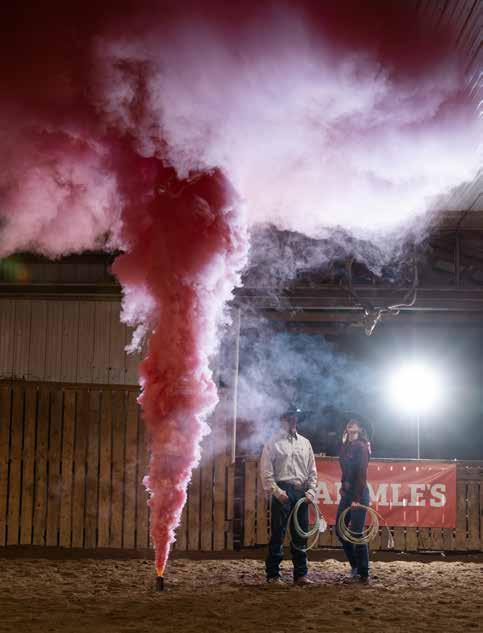
their dreams and it’s really awesome to see it paying off for them. They are most certainly inspiring a new generation of cowgirls and with all the craziness of the current world as we know it, this is truly something we at WHR are marvelling over. We know it takes belief in one’s self to accomplish those kind of feats, but we are also know it takes a very special support group in their corners to get to that level of excellence. So, to their men, children, friends and families – we salute you as well!
On page 24, you can read Aidan Nicholson’s newest instalment on succession planning. In this edition, he tackles the subject of intergenerational farm transfers and navigating Canadian farm capital gains taxes. At the time of press of this issue, our federal government is currently headed for an election and it’s important to note that this article was written before
the interim government made several announcements. One of which includes cancelling its plan to increase the inclusion rate, but still raise the lifetime capital gains exemption. Therefore, the inclusion rate at time of printing is one-half and the lifetime capital gains exemption is $1,250,000. Read more about Nicholson’s thoughts in this important feature.
Also in this issue we bring you some important equine health reads about Strangles and genetic testing of the Quarter Horse. Sometimes these topics make horse owners uncomfortable but with some of the latest research and discussion, we aspire for these articles to highlight some response measures and tips for prevention.
Wrapping it up are all our regular fashion, history and western lifestyle essays. As always, we hope you enjoy! ~ Jenn Webster




There was a girl born on the Saskatchewan land, she loved to ride horses, became quite a hand. Everyone could see it was a total no brainer, that she was born to be a full-time horse trainer.
Now I’ll tell you this Northern chick had some gall, ‘cause she went to work for the Hall of Famer named Ralls. She worked there day and night on her skills, he showed her how to teach her horses “the drill.”
From there she continued her horse training college, and worked for Todd Bergen, expanding her knowledge. When the time finally came, she went out on her own, where she and her new husband started their home.
Horse training sure ain’t for the faint of heart, It’s a mixture of sore back, frustration, and art Some days the struggle seemed almost too primal, Then she made the open futurity final.
From there, the cowgirl could not be stopped, she trained hard, relentless, on her way to the top. She soon added another skill to the fray, Jackie helped to put roping on her resume.
World’s Greatest Horseman, was the title she sought, a win in that crowd, sure cannot be bought. She needed a partner, and it might sound trivial. He came in a horse named Hazardouz Material.
The pretty roan stud had all of the parts, whenever she called on him, he gave her his heart. In this world, many times, there’s words that are spoken, about how glass ceilings were made to be broken.
I’ve recently become a proud-doting father, to the most beautiful little, cowgirl daughter. And some day when she’s older I’ll tell her with pride, of how I witnessed history that Saturday night.
I’ll tell her ‘Baby girl anything can be done, whether buckle, or title, or world to be won.’
I believe there were many a horseman that cried, and felt a touch of Cowboy pride, about what happened in the Will Rogers that night.
The night the glass ceiling was finally broken, And the World’s Greatest Horse-man, was a Woman. - Poem by Chet Martin

At the 2025 Art of the Cowgirl (AOTC), held February 25 to March 1 in Wickenburg, AZ, a Canadian cowgirl made headlines when her mount became the high selling lot at the event’s Invitational Horse Sale. Reaching a bid of $200,000, Soul Ridge Lamont Flame, owned and consigned by Keily Stewart of High River, AB was sold to Angela Husemann of Winnipeg, AB.
No stranger to AOTC, Stewart had previously consigned horses to the sale. However, she went into the 2025 auction with zero expectations.
“AOTC has been a really good place for me to showcase my horsemanship and has opened a lot of doors,” relays Stewart. “This horse was different than anything else I’ve
brought and a different breed than most of what’s consigned – which was a gamble in itself.”
Soul Ridge Lamont Flame is a 2018 bay Canadian gelding better known as “Ben.” He was started by Stewart’s father, Glenn, at their ranch in British Columbia and later on became a mount for Keily.
“I used him for my job on a cattle ranch and he quickly became my faithful go-to!” she explains.
“There are horses in our lives that open doors for us. At the time, that looked like having something that allowed me to have fun, try new things, learn and stay safe. Whether that was at brandings, ranch rodeos, at my job or roping. He was athletic enough he could kind of hang in any niche and he allowed me to really just let my guard down and turn loose.”
Keily relays that the experiences she had through Ben, were more valuable than any potential sale. At one point,
she had even told her father that she wanted to keep a “lifer” around, so she always had at least one trusty steed. A couple of seasons went by and Ben seemed to be in his prime of life and Keily began to consider consigning him to the sale.
“I had no expectations going into the sale! I know what my animals are worth to me and what I will take them home for. If that basis is covered, ‘faith and fear both demand you believe in something you cannot see,’” the cowgirl states.

“I think folks have seen enough of him over the years, whether it be on social media or in person, that it was easy to have a soft spot for Ben. They got to see us share organic and joyful experiences growing together, doing what we love. No deadlines, no agenda. Just living.”
She says there a few potential clients who set out to meet Ben ahead of the sale and in doing so, really solidified the draw they had toward him.
“I knew he had some forever homes hoping for him, but I had no idea at what capacity,” Keily admits.
“This year was the fourth and fifth horses I’ve offered at AOTC. I’ve always brought my best and letting them go has never gotten any easier. One day when my cards are right, I’ll hold onto every last one of them.
“I am very thankful for AOTC and the opportunity they provide for us cowgirls to showcase our horsemanship, as well as creating a community where it is appreciated.”
- By Jenn Webster




This year marks the third time trick rider Shelby Pierson has performed at Rodeo Houston, but this year was one for the books. Held March 4-23, 2025 in Houston, TX, Rodeo Houston is a 20-day tournament style rodeo that pays out over $2,500,000 in monies and prizes to its champions. Performing at the event has always been a dream of Pierson’s, who hails from a farm family in Wardlow, AB, but this year was out of this world.
“Performing at Rodeo Houston has been a dream of mine ever since I started trick riding at eight-years-old,” Pierson states.
“I remember watching old YouTube videos of Niki Flundra performing there and I knew that it was on my bucket list to perform at someday. It’s pretty hard to describe just how incredible that rodeo is –that stadium seats 75,000 people and it is absolutely incredible, all the way from the rodeo to the concert!”
Pierson’s sister, Kendal, also performed in Houston this year, in the Breakaway Roping. Kendal had to make a win early in the series, in order to advance to the finals. In the end, she broke out and made it to the final four round.
Watching your sister compete well at one of the world’s biggest rodeos was an incredible occasion and not one Shelby will soon forget. Performing for the massive crowds, with her family cheering her on, was a phenomenal experience. And just when you think it couldn’t get any better, Shelby had the opportunity to meet international superstar, Post Malone as she was leading her horse in for a performance.
“It was very surreal!” she exclaims. “I was warming up, getting ready to head in for my performance and [Post Malone] actually stopped as he was interested in what I did in the rodeo – I was dressed head-to-toe in my glitter for trick riding. He was super down to earth and just wanted to know more about the rodeo, which was so cool to see a celebrity take interest in our western way of life!”
- By Jenn Webster























With the looming threat of US tarriffs, we asked WHR readers what they might be stocking up on in their barns or stables. Here’s what they said:
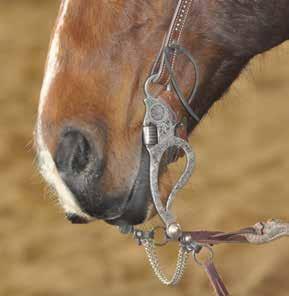
“dac® Vitamins and Minerals! Can’t go without!”
~Tyler Bennett
“
“ Depends on what the tariffs include! Otherwise I’ll say used quality tack to bring up.”
-
“Canadian beer!”
-Lindy Barron
Amber Dawn Copenhagen …. Not me, ‘my hubby. Lol”
-Tara McKenzie
“I wish I could get SWAT
in
Canada. I’d pay the tariff!”
~Janine Zuk
“Adequan”
~Patty Lee

At the National Reined Cow Horse Association Celebration of Champions held this past February 15 to March 1 in Fort Worth, TX, Alberta girl Sarah Wolfs secured the Reserve World Championship in Ltd. Open Bridle division. Aboard her mare Reydas Sugar Cat, Wolfs marked a 434.5 composite score to win $3,632 and one of those coveted neck ribbons you only see in special places.
“I’m still on cloud nine to have won aboard my mare, Reydas Sugar Kat!” Wolfs exclaimed.
“She has done more for me than I could have ever imagined and I am so grateful to be partnered with a horse with so much grit, talent and an unbelievable amount of heart. Thanks for the ride Reyda.”
Reydas Sugar Kat is sired by Kit Kat Sugar and out of the mare, Royal Reyda.

Riding One Time Up North, Arthur, ON, rider Chet Martin also took home a Reserve World Championship in the Finals of the Open Bridle. Up against a tough group of competitors, Martin and the stallion owned by Up North Performance
Horses marked a 438.5 composite to earn $9,495. They also tied for third position in the Open Bridle / Int. Open Bridle, for another $1,320. The pretty roan stallion is sired by One Time Pepto and out of Our Special Kitten.
If you need some direction on how to buy Canadian, here you go!

These quality sauces derived from the Jordan family’s generational recipes are proudly made in Canada. Available in seven gourmet flavours and in low-carb or gluten-free options, Jordan Ridge Sauces evolved from the company founder’s farm family recipes – back in the day when people made meals from scratch. These versatile dips and toppers are perfect on burgers, steaks, ribs, chicken, corn, scrambled eggs or even in your favourite Caesar! www.jordanridgesauces.ca
Handmade in British Columbia from high-quality paracord, products from Knots & Neighs are lightweight and sturdy. Everything from halters, reins, whips and breast collars –each piece is designed with the comfort of your horse in mind.
Find them on Facebook


If you’ve ever driven Highway 2 near Cayley, AB, you’ve certainly seen the iconic Happy Face Barn! Celebrate someone’s birthday with a card highlighting this southern Alberta attraction, from Western Hive. This classic card will make a special day even better with its cheerful “Happy Birthday” wishes. Made in Alberta, western inspired and accompanied with an envelope. www.westernhive.ca

Looking for a stunner of a gift? Check out the work of Alicia Nicole Wopereis. An artist from Okotoks, AB, Wopereis can hand-carve a favourite mount into leather and craft a cell holder that is perfect for riding. Never lose your phone in the arena dirt again! Find her on Facebook
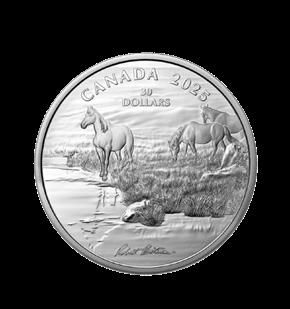
The newest coin from the Royal Canadian Mint features Robert Bateman’s Mustang Country, rendered in fine silver. With its 50mm diameter and its low mintage (only 4,000 will be available,) this 99.9% pure silver coin comes with a beautiful shimmer. With a face value of $30 CDN, and an engraved signature from Bateman, this coin is likely to see a good increase in value in the coming years. www.mint.ca
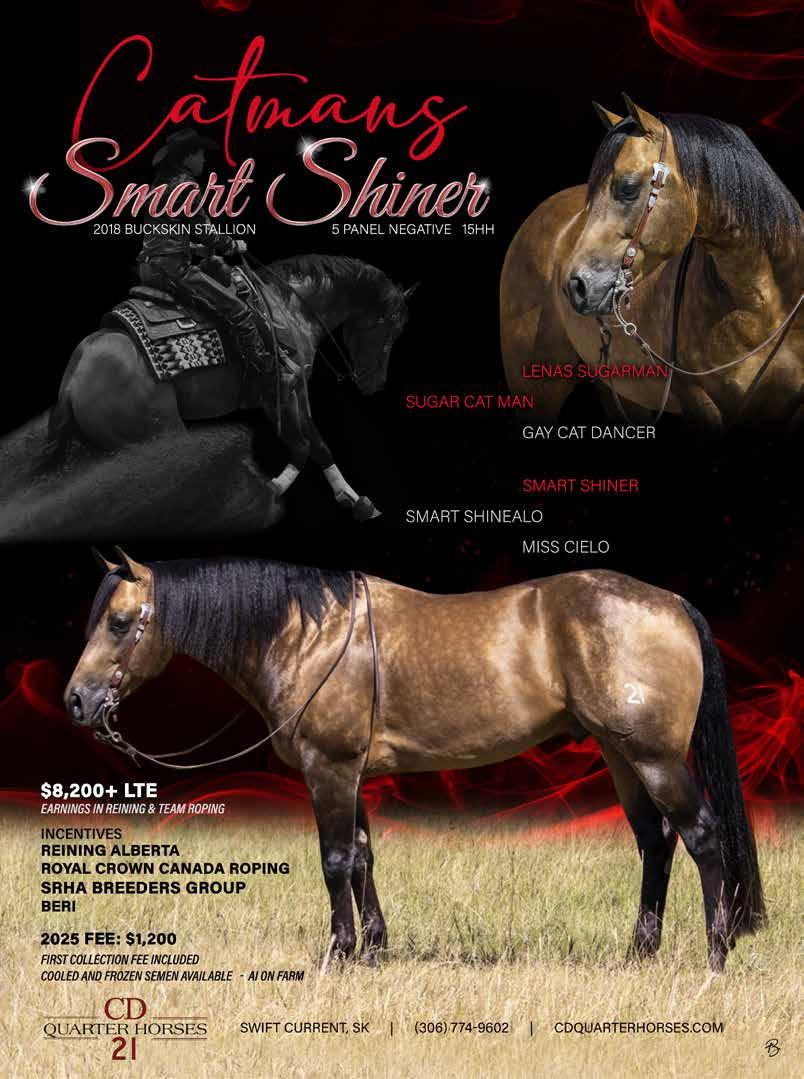

Here’s how anyone can bring the western culture into your life, without ever owning a horse.
BY MICHAEL J. NICOLA
The North American West is synonymous with the cowboy and the culture of the cowboy, but you don’t need to own a horse to embrace its rich heritage. According to renowned western photographer Nadine Levin, one doesn’t even have to call the West home. “If you can’t live in the West, you can surround yourself with the West. The West is in your heart, a code you live by. It’s not where you hang your hat.”
The Poolesville, Maryland, USA, home of Nadine and her husband, Alan is filled with great Western art. The couple are especially enamored with the functional works of art crafted by the members of the Traditional Cowboy Arts Association (TCAA). The TCAA offers an authentic connection to the West through the traditional cowboy crafts. In this way, the Levins are living the West. Like the Levins, people throughout the world want a part of the culture in their lives. Living the West is about embodying values such as honesty, integrity and hard work. The TCAA exemplifies these principles while preserving the traditional Cowboy arts and educating future generations.
The TCAA focuses on four main disciplines: saddle making, bit and spur making, silversmithing, and rawhide

braiding. These crafts are not just about creating functional items for horseback riding and work; they are also about preserving a way of life –embracing the values, culture, and traditions of the cowboy way.
Twenty-seven years ago, a core group of celebrated cowboy craftsmen – concerned that the traditional cowboy crafts were fading into oblivion, only to be replaced by soulless objects of mass production – came together. Ken Townsend, President of the National Cowboy and Western Heritage Museum, and Curator Don Reeves believed in their mission and facilitated their annual sale and exhibition starting in 1999. The partnership with the museum, gave the TCAA members the opportunity to raise the level of their craft to art each year. After a quarter of a century, the TCAA has continued year in and year out to astonish the public with their artistic works.
Thus, the journey of helping all of us live the West began through working gear as art in museums and our homes. Each piece created by the TCAA artisans tells a story of dedication, skill, and a deep connection to the land and its history. After all, each member of the TCAA is also a working cowboy.
“I feel fortunate to have spent my life
in the rural areas of the West,” says Ernie Marsh, a TCAA bit and spur maker. “It’s been the vast open country, combined with our horse and cattle culture that have provided many years of inspiration. I hope that patrons acquiring my work can enjoy living the West knowing that my art truly depicts the working cowboy.”
Through their work, the TCAA embodies the code of the West, and this code is based not on myth, but on the reality of life on the open range. Granted, most folks who don’t physically live in the West may not know of the code, but they are drawn to it through great writings and art.
Lance Benham, a friend and Western art collector, has witnessed firsthand, the way the TCAA works impacts others.
“Over the years and having attended many of the TCAA exhibitions and sales, [my wife] Linda and I have a number of pieces that are quite meaningful to our family. When we began our purchases, we did so because the work was so stunning and we couldn’t say ‘no!’” he states.
“As our collection grew and we began to arrange pieces alongside our other western artwork, we noticed that our family and visitors saw something we hadn’t intended. Many told us our collection is more than art… that the pieces spoke


to the real West. As folks experience our paintings and sculptures many are stunned to see hand-braided reins, hand-made saddles, and hand-stamped silver work that complement the rooms. When we explain the TCAA organization and speak to the small number of artisans from the ‘Americas’ who comprise it, people are stunned to learn how the pieces are actually made,” Benham relays.
“By honoring the methods of the past in their creative efforts, the TCAA artists bring not only mastery of their western craftsmanship to our home, but also provide a celebration of the West through the simple, elegant, and practical presentation of pieces that fit naturally among our paintings and sculptures.”
Indeed, seeing a pair of spurs on the mantle above a fireplace or a saddle in a board room makes the West come alive immediately. Simply touching these pieces ignites an excitement. The energy of the artist is transfused in all of us. Stories of survival and endurance and courage are no longer just on the movie screen, but come to life with their presence.
“These pieces transcend their functional origins, becoming art forms that deserve appreciation and a place of prominence. It is a true art to display them in a way that honours their craftsmanship while

In celebration of the 25th anniversary of the TCAA’s first exhibition held at the National Cowboy Museum in 1999, the group auctioned a project called “The California Rose” in which all 13 active TCAA members, plus one emeritus member, took part.
enriching the surrounding space,” says San Diego, CA, USA interior designer Rebecca Welch.
“Educating clients about how these extraordinary works of art – whether handcrafted leather goods, saddles, or other heritage pieces – can seamlessly integrate into any style of home, is essential. Supporting the talented western artisans of the Traditional Cowboy Arts Association is a cause close to my heart.”
At the TCAA Exhibit and Sale every year, each of the artists work to exceed their efforts of the previous year. There is a two-fold reason for this. Firstly, they don’t want to disappoint or let down their fellow artists. For instance, Wilson Capron, a renowned bit and spur maker, will certainly be looking at the quality of the silver work Canadian artisan Scott Hardy creates. Secondly, these artists take personal, deep-down pride in their work.
Living the West doesn’t require owning a horse. Through the Traditional Cowboy Arts Association, individuals and families can immerse themselves in cowboy culture. By embracing this functional cowboy art, anyone can bring the spirit of the West into their life, no matter where you live.
The 26th annual sale and exhibit returns to the National Cowboy and Western Heritage Museum in Oklahoma City, OK,
USA on September 26-27, 2025. For more information, visit: www.tcowboyarts.org


Butter, cheese, flip, flambé then douse the flames out with lemon!
BY TIM HILLER
Saganaki is a Greek dish, one of many cooked in a small pan. The pan is actually how this appetizer got its name – traditionally a small, heavy pan with two handles, that originated from the Turkish word “sahan” or “sagani.”
Tim Hiller put his own spin on this recipe by crafting a pan out of mild steel, which is small enough to fit into his saddle bag.
The secret in the perfect Saganaki is choosing the right cheese. Graviera, Kefalograviera and Kefalotyri are all traditional options used in Greece. However, there is a specific “Saganaki” cheese that can be purchased in North America which is labelled as such. Typically, the cheese is made from cow or goat milk.
When the dish is prepared it can be a show-stopper recipe,
as it’s often flambéed table-side. This involves frying the cheese first, pouring Ouzo, Brandy or Sambuca overtop, lighting the whole thing on fire and finally, extinguishing the flames with lemon juice.
However, the flaming dish is actually frowned upon in Greece, as the flambé originated from a restaurant in Chicago in the 1960s. In its traditional form, the juice of a lemon is squeezed overtop of the fried cheese only.
The dish can be eaten alone (as a starter), or mixed in with other ingredients for a main dish like prawn saganaki. Still, whichever way you prefer to eat it, we like Hiller’s Trail Ride version the best!
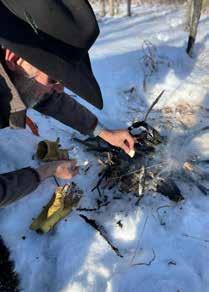
1 Block Saganaki Cheese
Egg White
1 Cup Flour
1 Tbsp Butter
1 Small Shooter Bottle Sambuca
1 Small Ziplock Bag
1 Lemon
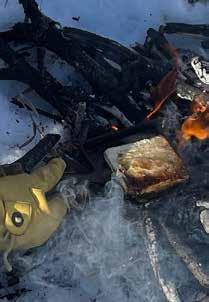
For cooking, you will need a small cast iron or steel pan that fits the cheese and don’t forget the matches! If you are preparing this dish on the trail, pre-dip the cheese in egg and close it in a Ziplock baggie with flour, before you pack it into your saddle bags. Otherwise, dip the entire piece
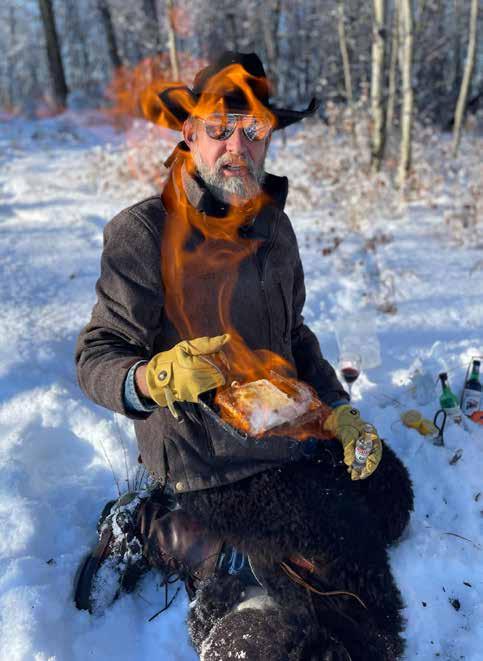
of cheese in egg white then dredge in flour. Preheat your pan over a fire. Melt the butter but do not brown it! Carefully set the cheese into the pan, avoiding any splashing of the butter. Brown both sides and remove your pan from the fire.
Now you can pour a quarter ounce of Sambuca over the cheese and light the flambé. Do so by simply returning the pan to the fire to ignite the flames, or use a long barbecue match. Once the flames start to die down, squeeze your halved lemon overtop of the cheese. The longer you leave the alcohol to burn, the more flavour will remain. Or as the Greeks do, leave out the flambé and use the lemon juice.

About the Chef:
Tim Hiller packing the ingredients up into his saddle bags. His book, Cooking the Cowboy Way can be found at: www.ironarts.ca

For tax purposes, “farming” includes ranching and beekeeping, and likely includes feedlot and stock contracting. Alex Callaghan
BY AIDAN NICHOLSON, J.D.
ince the Federal Budget was tabled in April of 2024, there has been a lot of talk about how proposed changes in tax policy will affect producers when selling or transferring farm property. The Budget revealed that the capital gains inclusion rate would be increased from one-half to two-thirds, which has (for good reason) stirred up a lot of criticism and frustration among Canadians, especially farmers and ranchers. Based on the proposals, this increase in the inclusion rate on capital gains would be subject to a $250,000 safe harbour for individuals (half of the capital gains up to $250,000
would be taxed), but this safe harbour does not apply to trusts or farm corporations. At the time of writing this article, the word on the street is that the CRA is intent on enforcing these changes even though the changes have not received legislative approval from Parliament. The proposed changes would create one of the highest capital gains tax regimes in the world. Despite the uncertainty of whether the proposed changes will become law in light of pending legal challenges, either way you cut it, capital gains and their tax treatment have a significant impact on family farms and their succession planning efforts.
When farm property is disposed of, capital gains may arise by virtue of actual or deemed dispositions. Whether the farm is looking to sell or divest its assets, make lifetime gifts to family members, or transfer farm property by will, there may be significant capital gains and therefore significant tax implications. When the capital assets of the farm are sold or otherwise transferred, that tax hit could be felt more severely if the proposed increase to the inclusion rate takes effect. Thankfully, there are so-called “relieving” provisions in the Income Tax Act which allow farm property to be transferred to family members on a tax-deferred basis or enable producers to eliminate or minimize their tax burden on the transfer of certain farm property in many circumstances. This article will highlight how farm capital gains are treated from a tax perspective and their impact on the financial viability and operational longevity of family farms. This will provide a solid basis for the next article in this series which will examine various ways farm property can be transferred to family members in a tax-effective manner.
Producers can claim a capital gains exemption to reduce or eliminate the tax burden when they dispose of farm property, provided that the property is classified as “qualified farm property” under the Income Tax Act. While farm property must be qualified farm property in order to claim the capital gains exemption and minimize or eliminate the capital gains tax on the disposition, certain rollovers can still be implemented to defer the tax on transfers to family members even if the farm property does not constitute qualified farm property. In some
cases, both the capital gains exemption and rollovers may be available and utilized. Generally, if farm property is classified as qualified farm property, there are more options for farm families to relieve their tax burden and maximize tax savings, create and implement more dynamic and robust succession planning strategies, and facilitate smoother intergenerational transitioning. All of this, in turn, can help preserve the family legacy in the long run.
For farm property to be considered qualified farm property, specific ownership and use tests must be satisfied. The general, overarching definition I would formulate would be this: qualified farm property is farm property that has been owned by an immediate family member for at least two years, used principally in the course of carrying on a farming business by an immediate family member who, through being actively engaged on the farm on a regular and continuous basis, earned more gross revenue from farming than other income sources in at least two of the years the farm was owned. The kinds of farm property that can qualify include farmland, pastureland, buildings, shares of a family farm corporation, interests in a family farm partnership, quota, and equipment. Now, let’s break down that definition.
There are several criteria relevant to determining whether farm property meets these qualifying conditions. First, the property must be used principally in the course of farming. By the way, for tax purposes, “farming” includes ranching and beekeeping, and likely includes feedlot and stock contracting. Principal use means that farming is the primary use of the property such that at least 50% of the property has been used primarily for farming purposes in any 24-month period in which the property was
owned. This leads into a related test pertaining to how farm assets are used. All or substantially all (90% or more) of the farm assets must be used principally in the course of carrying on a farming business. Next, we need to consider what is meant by active engagement on a regular and continuous basis. Determining whether someone is actively engaged in farming on a regular and continuous basis is fact-specific and assessed on a case-by-case basis. Generally, however, this requires active engagement in the labour, management, or other daily activities that contribute to the overall success of the outfit. As for whether these activities are done on an active and regular basis, this simply means that the activities are undertaken frequently and at regular intervals.
Property that is leased to a third party non-family member can still meet the requirements for qualified farm property but determining whether it does requires a detailed tax analysis of your specific circumstances. Moreover, even if the farm property being disposed of does not satisfy the requirements to be qualified farm property, there may be other options and strategies available to limit tax liabilities. Every family is different and every farm is different, so while intergenerational transfer strategies can get quite complicated and complex, they can also be very creative and unique. Farm management and family dynamics heavily influence what sorts of intergenerational planning options are available or suitable. The analysis therefore always depends on your situation, which is why it is crucial to consult with legal and tax practitioners and plan proactively based on the specific circumstances and objectives for your operation.
Now that the most important requirements for claiming the capital gains exemption on farm property dispositions have been described, let’s dive into what exactly the capital gains exemption is and how it works. As alluded to, the capital gains exemption can significantly reduce the tax burden on gains realized from the sale or transfer of qualified farm property. Every individual resident in Canada can claim a deduction against taxable capital gains realized from the disposition of qualified farm property. As noted, there is a lot of uncertainty right now about whether the CRA is enforcing the proposed regime which increases the lifetime capital gains exemption for qualified farm property from roughly $1,016,000 to $1,250,000 and whether they are using the proposed inclusion rate of two-thirds or the old inclusion rate of one-half. For illustrative purposes, I will assume that the CRA is currently using the increased numbers as proposed by the Feds. This would mean owners of qualified farm property could reduce their taxable capital gains by $1,250,000. If property is owned jointly with more than one person, each owner can utilize their lifetime capital gains exemption on the capital gains allocated to them based on their respective legal ownership interest. This effectively increases the total exemption amount available and creates additional tax savings. By way of example, consider a farm family where the

Whether the farm is looking to sell or divest its assets, make lifetime gifts to family members, or transfer farm property by will, there may be significant capital gains and therefore significant tax implications. Leah Leduc
husband and wife own all their qualified farm property jointly and individually (i.e., not through a farm corporation). Let’s say they sell or transfer their qualified farm property resulting in a capital gain of $5,000,000 and they do not use any available rollovers (more on these in the next article). Because they own the property jointly, both spouses each have a capital gain of $2,500,000. However, because the property is qualified farm property, they both may claim their lifetime capital gains exemption and reduce that by $1,250,000. This brings the capital gain down to $1,250,000 per spouse, and, again, we are assuming that the proposed capital gains changes have come into effect. Now, since the husband and wife hold the property individually, they can take advantage of the safe harbour such that one-half or 50% of the $250,000 and two-thirds or 66.67% of the remaining $1,000,000 of their respective capital gains will be taxed. The result is that both spouses will each have a total taxable capital gain of $791,700 instead of $2,500,000. That total capital gain is then what is ultimately taxed at provincial and federal income tax rates.
While this example is meant only to show how the lifetime capital gains exemption works, there are several other important implications affecting tax treatment, such as the principal residence exemption and alternative minimum tax, which is why it is crucial to consult with qualified tax and legal practitioners. Furthermore, the capital gains deduction is a lifetime limit, meaning the amount is available for producers to deduct from over the course of their lives if they do not exhaust the full amount

in one transaction. This can provide a substantial tax benefit, significantly reducing or altogether eliminating the total taxable capital gain realized – and thus the total amount of payable taxes – on the sale or transfer of qualified farm property. It goes without saying that excluding a significant portion of your capital gains from taxation can facilitate the intergenerational transfer of farm property and alleviate the tax liabilities with which family would otherwise be saddled.
As seen in the example above, there can be massive potential tax savings if you work with the right professionals to get your ducks in a row. An augmented tax regime is particularly harmful to family farms that are “asset rich, cash poor” and present yet another challenge for producers to deal with. It is difficult enough for future generations to get into ag; with a higher tax bill, kids will have an even harder time buying out their parents and taking over the operation. By seeking proper guidance and advice,

FIRST, THE PROPERTY MUST BE USED PRINCIPALLY IN THE COURSE OF FARMING. BY THE WAY, FOR TAX PURPOSES, “FARMING” INCLUDES RANCHING AND BEEKEEPING, AND LIKELY INCLUDES FEEDLOT AND STOCK CONTRACTING.
however, there are ways to reduce, eliminate, or defer capital gains, ease the tax load on the family, and set the operation up for continued success. There are plenty of other tax strategies that could be available, some of which will be discussed in the next article of this column which will focus on various types of intergenerational transfers. By working with tax and legal professionals to navigate complicated tax rules, ensure tax reporting compliance, and maximize available tax benefits, farm families can improve the longterm viability and financial health of their operations across generations. It is your legacy and our heritage; it should be structured to last.
*This article is provided as a source of information only. It does not constitute legal advice or tax advice and should not be relied on as such. Readers are cautioned not to act on the information provided without seeking specific advice from legal and tax practitioners with respect
Aidan Nicholson is a lawyer practicing wills and estates, agricultural litigation, and business law at Field Law in Calgary, Alberta. Coming from a family that lost their farm, he understands the difficulties Ag families face when striving to protect their legacies. He is a fierce advocate for agriculture in general and family farms in particular, fighting for producers and ensuring their voices are heard. When he’s not in the office, Aidan lends a hand on ranches and feedlots around southern Alberta, works on his horsemanship, and makes as many stops on the rodeo trail as possible. He is a volunteer with the High River Ag Society and a member of the National Cutting Horse Association (NCHA). To discuss succession and estate planning, or any of the issues and topics discussed in this article, Aidan can be reached at anicholson@fieldlaw.com.

BY MONIQUE NOBLE
trangles is a word that strikes fear into any equestrian’s heart. Highly infectious and horrible to deal with, Strangles is a nightmare. While it’s unlikely to kill you or your horse, it will scare the crap out of you and seriously gross you out.
Strangles is caused by the bacterium Streptococcus equi equi (S. equi). The bacteria enters mucous membranes in the nose and mouth infecting lymph nodes causing them to abscess and eventually rupture. Older horses generally have an easier time of handling infection and don’t always develop abscesses, but the younger the horse, the worse the infection can be.
Usually presenting in the upper respiratory tract of horses, Strangles shows up as nasal discharge and abscessed lymph nodes under the jaw. Unfortunately, in some cases it can travel to other areas in the horse’s lymphatic system causing serious and sometime fatal complications. When this happens, the disease is referred to as Bastard Strangles – a fitting name.
Thankfully rare, Bastard Strangles can cause internal abscesses throughout the body. Organs such as the brain, liver or kidneys, can be compromised, abscesses rupturing in any of these organs can spell death for an ill horse. Signs of Bastard Strangles include swelling in areas such as the eye, temple, sheath or hocks and it requires immediate veterinary care.
In addition to Bastard Strangles, Purpura Hemorrhagica (PH) is another secondary complication that needs to be watched for. PH in horses is typically triggered by an abnormal immune response following Strangles and may develop weeks or even months after the initial infection.
Left untreated, PH can cause serious complications, including tissue necrosis and secondary infections, which can severely impact the horse’s health and lead to death. Early diagnosis and veterinary treatment are essential to control the condition and prevent further progression.
Signs of Purpura Hemorrahagica include intense and hot swelling in parts of the body including the head, neck and chest. Infected horses may also present with muscle pain and stiffness. Bruising and small reds dots (petechia) may appear on mucous membranes.
With such severe complications possible, Strangles must be taken very seriously. When handled carefully, most horses recover completely and go on to regular careers. Bastard Strangles can cause some residual complications, but they are not necessarily career-enders.
Strangles is a sneaky bacterium and can be there long before you know it exists. After entering the horse’s nose or mouth, it travels to the throat and incubates for 3 to 14 days and

sometimes longer. Dr Suzon Schaal of TD Equine advises, “The strains we have been getting the past couple of years have seemed to have longer incubation times, so they are closer to the 21 days and can surpass it. So three to four weeks would be an appropriate length of quarantine time for your horse.”
Once the infection settles in the horse will present a fever, look lethargic and go off their food. If you act quickly and isolate the fevered horse before they start getting sticky and shedding bacteria, you may be able to prevent the bacteria from infecting any other horses. If you suspect a horse has been exposed, checking their temperature twice a day may help you catch the infection before it is passed on to others.
Once the fever abates, thick white nasal discharge, stringy saliva and coughing may present, along with enlarged lymph nodes under the jawbone.
Infected lymph nodes swell painfully, eventually breaking open and draining purulent material. The pus draining from lymph nodes or present in nasal discharge is teaming with bacteria that easily infects other horses and contaminates surfaces. Ruptured Lymph nodes are hard to look at, but there is a bright side – once the abscessed nodes rupture the horse usually recovers quickly.
In 2024, the Alberta horse community faced many Strangles cases. Hopefully, the lessons learned from last year, combined with some myth-busting and practical tips for reducing exposure risks, will help everyone enjoy a much better 2025.
This Too Shall Pass
Strangles typically doesn’t require treatment so much as quarantine and vigilant cleaning of the surrounding environment to prevent its spread to other horses. It usually subsides on its own, but must be watched carefully.
Strangles can stay active in water buckets and moist areas for four to six weeks, and the bacteria can survive for about one to three days in drier areas such as on fencing or in soil. It can survive being frozen, but does not do well in dry heat.
Isolation is Crucial
The bacteria is primarily transmitted through noseto-nose contact with an infected horse, but horses can catch the illness by encountering something contaminated with the bacteria, such as buckets, people, other animals present – cats / dogs / flies.
Don’t treat it until you know what it is – unless a horse is having complications, it is best not to treat with antibiotics. A recent study showed that horses that were treated with antibiotics early in the cycle of infection had reduced residual immunity against the bacteria.
The younger the infected horse is, the more vigilantly you need to watch it for complications. While complications are not an immediate death sentence, they are difficult to treat. Contact your vet immediately if you see any abscesses, swelling, or red spots in other areas of the body.
Once Strangles is on a property it stays there.
Strangles can survive for days or for weeks if frozen, but It’s generally a very poor survivor usually only living for hours or days, not weeks or months. An area that has gone through an outbreak is not a risk forever. When all infected horses have recovered and nasal swabs are negative for S. equi, the soil and surroundings should no longer be contaminated from that outbreak.
Strangles is like chicken pox, once they get it they can’t get it again. Immunity to strangles following an infection is generally strong, but it’s not necessarily lifelong. Some horses may be reinfected within five years of a Strangles infection. If a horse is exposed a second time they are more likely to show only mild to no clinical signs. During this time however they can still spread the bacteria to other unprotected horses.
Treat immediately with antibiotics.
Antibiotics too early can make a Strangles outbreak get worse and last longer. Treating Strangles before it is necessary may also reduce the amount of immunity the infected horse builds up to fight off future exposures.
Strangles is inevitable.
While Strangles can be hard to avoid, the 3 Ds – Distance, Disinfect and Diligence are your best defence. Many facilities and events do disinfect beforehand, but it is always best to do it again, like gym equipment.
If it doesn’t have lumps it’s not Strangles. While classic Strangles does appear with lumps under the jaw, in older horses the lumps are not always present. A horse that looks like it has a cold could still have Strangles and be shedding bacteria.
Horses are only infectious for the first few weeks. Horses can carry Strangles for years. A horse’s nose is a complex instrument and much like ours it collects debris; mucus can harden within it. Solidified mucus can stay in a horse’s nose for an unspecified amount of time. To ensure a horse is no longer a carrier a nasal cavity flush and scope is necessary. Vet’s will search for any hidden mucus, flush it and test it for live bacteria. Once a horse has no more infected mucosa in their passages, they are Strangles free and will not be carriers.

Vaccinating and the 3 Ds; Distance, Disinfect, and Diligence are your best defense.
There are vaccinations for Strangles available. Horses recently exposed or ill with Strangles should not be vaccinated while/or immediately after an outbreak, but unexposed horses can be. While there have been extremely rare cases of Strangles being caused by the live vaccine Dr. Lockhart DVM from Moore Equine asserts, “The best preventative, is to increase immunity through vaccinations.” Chat with your vet about which vaccine would be your best option.
DISTANCE - If you think you or someone else has an infected horse – even if it could be allergies or a cold – isolate the horse. If it’s not your horse inform the owner of your concerns. If you have a horse that is showing any signs of congestion or lethargy – STAY HOME and do not let horses on or off your property. When doing chores around a sick animal use designated buckets, halters/leads, brushes, forks and shovels and disinfect them before and after use. Wear a separate pair of rubber boots and disinfect them before and after every use as well only using them when working with the infected animal. Wear disposable gloves and a designated chore coat. Be hyper aware of what you are handling – and disinfect items accordingly.
Do not share fence lines, water sources or equipment with sick horses.
DISINFECT - Everything. EVERYTHING with a diluted bleach solution (50 per cent water / 50 per cent bleach) or Virkon. And remember that if the bottle doesn’t state “disinfectant” on the label, it may only be a “whitening” bleach. In which case, the product does not disinfect properly against this disease.


· Antibacterial wipes
· Rubber gloves
· Ziploc bags
· Thermometer
· Rubber Boots
· Iodine Solution
· 20cc Syringe
· Container like a mason jar
Dispose of the wipes or cloths by putting them in a Ziploc bag and throwing it in the trash or if you have one, an incinerator.
The iodine, syringe and container are to flush out abscesses.When your horse abscesses, you can apply hot compresses to help the abscesses mature. Once they burst, flush the abscesses with an iodine solution (3-5% iodine added to clean water) until they dry out. Your vet will be able to walk you through this lovely procedure.
Irrigating and letting the abscesses drain will help them dry out and heal faster, while also hopefully killing most of the bacteria present in the pus. Do not bandage the open abscesses and do not flush out abscesses near eyes or ears.
Spray down stall walls, and floors. Don’t forget to wipe down common surfaces like switches and door handles. If you are going to be out and about with your healthy horse, disinfect tie rails, walls and areas they are going to be in.
– Commit to keeping your horses away from unknown horses, surfaces and water sources. It can be difficult to do but is the best way to keep your horses safe. Horses can be carriers without their owner’s knowledge. If you think your horse may have been exposed, quarantine them for a minimum of two to three weeks. Some people say two weeks is enough but Strangles should never get the benefit of the doubt, the longer the quarantine the better.
· Avoid trailering with unknown horses if you can, quarantine your horse afterwards if you can’t.
· Wash your hands or disinfect them before working with one horse then another.
· Do not share equipment like halters, bridles or bits without disinfecting items first.
· Quarantine any new horses or horses with possible symptoms.
· If you think your horse may be exposed, check twice daily for a fever. This will be your first sign of illness. Isolate them immediately if they have a temperature above 38.5º.
Irrigating abscesses is not a fun experience for you nor your horse, however nursing your horse back to health can be an incredible bonding experience for you both. Spend some quality time together as they recover. Animals should not be ridden while sick, but they’ll appreciate your company and grooming them is the best way to stay on top of any possible complications.
Hang in there, most cases resolve within six weeks, and you should be able to start riding again when your horse is symptom free. Hopefully by following these guidelines and staying vigilant together, we can all help protect our horses, our stables, and our equine community from the struggle of Strangles.
Remove the stigma. No one wants to talk about Strangles and many people prefer to keep infections on the down-low. However, this act does nothing but help spread the disease. Changing your plans because of a sick horse is unfortunate, but for the best. Many horse sport associations try to foster a horse health-forward environment, by treating possible cases on an individual basis.


If you’ve entered a clinic, event or show and your horse comes down with the disease, your association may be able to help you out with a partial, if not full, refund of fees. Often, this refund won’t affect event pay-outs either.
If you are concerned someone else may have a sick horse on site at an event, speak to the management team. Most associations reserve the right to request that an ill horse be removed from the venue.
Compassion – If a horse develops Strangles and you have done everything you can to prevent it, you are in good company. It is highly transmittable, and symptoms often don’t show up until horses have been contagious for a few days. Most times there is no one to blame and the best thing to do is forgive yourself and everyone involved, deal with the illness as a team and move forward.
When your horse has Strangles the only thing you can do is isolate and observe them while keeping the environment as sterile as possible as the infection runs its course.
Check on your horse at least twice a day. Strangles can turn nasty quickly. Isolate them in an area they can stay in for the next three to six weeks, preferably without moving them and infecting another area. Do not let them share water sources or fence lines with other animals. Infected horses can be outside while ill, and do not require stall rest, however stalls are a much easier environment to control.
If your horse gets typical Strangles, you don’t have to do much other than make sure you are maintaining a system of sterility and care for the abscesses.
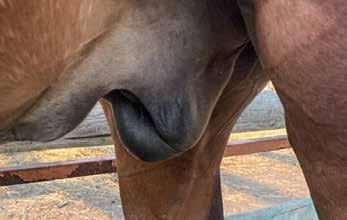






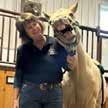

If current DNA and parentage verification standards are somewhat mind boggling, you’re not alone. Here’s the lowdown on panel testing for six genetic diseases the Quarter Horse breed is currently facing..
BY RYAN FLEETWOOD
The policy makers involved in the American Quarter Horse Association (AQHA) decided some time ago, that facing the genetic issues of the breed was the best way to deal with them. Genetic disorders that were verifiable through testing were required to be on file for all AQHA stallions as of 2015. This allows any AQHA member to request the results of any stallion, regardless of
ownership. The genetic test results on any stallion are public record. The idea behind this concept was so that breeders could use test results as one of their items to consider when making breeding decisions.
Here is a run down of the five genetic disorders that made up the original five panel genetic test (mandatory for stallions as of 2015):
Affects: Approximately 3.5% of Quarter Horses are carriers, with most cases found in cutting and cow horse disciplines. It is estimated that 28% of horses in these disciplines carry one copy of HERDA. Breeding horses should be tested to ensure the risk of producing HERDA affected horses is minimized.
Description: HERDA is a skin condition that is characterized by hyperextensible (more elastic than normal) skin, severe scarring, and open wounds along the back of affected horses. HERDA causes collagen between skin layers to not form properly, resulting in a horse that is easily injured. Collagen is important in connective tissues throughout the body including components in the eyes, heart, tendons, cartilage, and skin. The mutation in the PPIB gene results in defective collagen that causes the outer layer of the skin to split from the layer underneath. In many cases, the outer layer of the skin sloughs off entirely, leaving raw wounds. Young horses with HERDA might appear to have an unusual number of nicks and cuts on their skin, but the disease is most often noticed when the horse starts training under saddle.
Pictured Right: Fig. 1. Phenotype of HERDA-affected horses. (A) A 2-year-old HERDA-affected stallion with mild lesions concentrated along the dorsal aspect (white circle), including early indications of loose, sloughing skin (white arrow). (B) Extensible skin in affected tissue can be more easily separated from the underlying fasciae. (C) A large hematoma developed at approximately 1.5 years of age along the left dorsal side of this affected horse. (D) Additional ulcerations and degeneration of the skin as seen on the right dorsal side of the horse shown in C.
Affects: Approximately 8-10% of Quarter Horses, most commonly found in western pleasure and cutting horse industries. Paints can be carriers, as can Appaloosas and breeds that descend from the Quarter Horse. An estimated three or more percent of second and third-term abortions are caused by GBED. Affected animals may be aborted or stillborn, and foals that survive to term will die. Foals may appear healthy for a time but eventually may develop seizures, become too weak to stand, or in some cases, die suddenly.
Description: The mutation of the GBE1 gene reduces the function of the glycogen branching enzyme so that cardiac and skeletal muscles, the liver and the brain cannot store and mobilize glycogen. Because glycogen provides energy to the muscles, the inability to properly store and mobilize it leads to muscle weakness and eventually death.





Pictured above: In 1992, researchers designated the Impressive line of horses, once noted for their exceptional halter conformation, as carriers of hyperkalemic periodic paralysis (HYPP). Not all horses of that line have HYPP, but all horses with HYPP descended from Impressive himself.
Affects: Approximately 4.4% of Quarter Horses are carriers of HYPP, most commonly found in halter horses. HYPP is characterized by sporadic attacks of muscle tremors (shaking and trembling), weakness, and/or collapse. Sweating and prolapse of the horse’s third eyelid can occur when blood potassium levels rise. Attacks can also be accompanied by loud breathing noises resulting from paralysis of the muscles of the upper airway. Under the proper care, many horses have minimal symptoms and can go on to have successful performance careers.
Description: The mutation in the sodium channel gene causes dysfunction in a specific type of sodium ion channel. These channels are involved in generating electrical impulses associated with muscle contraction. The mutation disrupts the proper conduction of these impulses, causing muscle tremors and even temporarily paralysis in affected horses. In severe cases, HYPP can cause collapse or sudden death.
Affects: Approximately 11% of Quarter Horses are affected by PSSM, as well as many other breeds. PSSM is a disease that causes an abnormal accumulation of glycogen, the form of sugar stored in the muscle. This excess sugar causes mild to severe muscle cramps, sore muscles and/or muscle weakness. Horses that are managed properly can generally go on to have successful performance careers.
Description: PSSM is a common form of tying up. The mutation in the GYS1 gene causes unregulated synthesis of glycogen, which results in excessive sugar in muscle cells. This leads to muscle pain and stiffness, sweating, exercise intolerance and weakness. Because of the pain and stiffness, horses are reluctant to move.
Affects: Quarter Horses and several other breeds; the percentage of affected horses is unknown, though it is most commonly found in halter horses. MH is a genetic mutation that causes a life-threatening condition triggered by certain anesthesia drugs such a halothane or isoflurane. MH can also be triggered by stress or excitement.
Description: The mutation results in a malfunctioning calcium-release channel of the sarcoplasmic reticulum in skeletal muscle. During an episode, a horse with MH will release uncontrolled amounts of calcium into the bloodstream, which results in painful muscle cramps, extremely high temperatures (up to 113 degrees Fahrenheit,) an irregular heart rhythm, excessive sweating and shallow breathing. This can cause a hypermetabolic state (increased metabolism) and may result in death. A horse that has PSSM or MYHM in conjunction with MH will likely have much more severe episodes.
As a breeder of Quarter Horses and an AQHA Director, I am an interested party to the happenings that directly affect my business, so I work to try and get proper information to fellow Quarter Horse enthusiasts. In my opinion, AQHA doesn’t always get it right as far as getting out ahead of impending changes and there is often inaccurate information floating around for others to pick up and proliferate. There seems to me much misinformation available as to what AQHA is doing with the five panel test becoming a six panel test, with the inclusion of MYHM (IMM).
In a nutshell; the five panel test we’ve known since it’s inception (required for all breeding stallions as of 2015,) is now a six panel test with the addition of MYHM. The panel test remains mandatory for breeding stallions filing a Stallion Breeding Report.

Affects: A relatively newly discovered genetic disorder affecting about 7% of Quarter Horses. This mutation makes horses susceptible to disease. Horses with the mutation exposed to environmental triggers will develop symptoms of this disease. Not all environmental risk factors are currently known. Therefore, it is impossible to say if, or how a horse with the MYHM mutation will be affected. This makes it important to have your horse tested, as management is key to preventing an episode.
Immune-Mediated Myositis (IMM) is one form of clinical disease caused by MYHM. This results in muscle atrophy that is suspected to be the result of a response to a vaccine or infectious agent such as Strangles. The immune system misinterprets the muscle cells as foreign and rapidly attacks them. Horses initially experience stiffness, weakness, and a decreased appetite followed by the rapid loss of 40% of muscle mass within 72 hours.
MYHM is a dominant mutation, which means your horse only needs one copy to be affected, though not all horses with the mutation will become affected. They must be exposed to a trigger to experience symptoms. Horses that are homozygous (My/My) are likely to experience more severe symptoms.
IMM is most frequently triggered by infections, particularly with Streptococcus species.
Contrary to what I read and hear out there, there is NO stipulation of a minimum number of mares bred or anything like
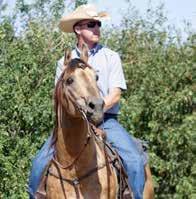
that surrounding the requirement to six panel test stallions. It very simply has become a six panel test with the same mandatory requirement to be done on all breeding stallions, just like the old five panel was.
Another myth I see often that I think needs dispelling; this will not increase the price of genetic panel testing, and it is not an attempt by AQHA to just charge more. I would urge folks to look at the whole, big picture of the genetic disorder reality and consider how to best deal with it from the association’s standpoint; and if you don’t like how it’s being done, get involved, head to the AQHA Convention and have your voice heard – as that is where all policy is discussed/decided.
Owners of stallions tested for five panel between 2015 and 2022 can contact AQHA and ask to have the MYHM results added to their stallion’s panel for $20. It can be done with the existing DNA on file, you do not have to send in a new sample. This is not mandatory, as five panel-tested stallions are not retroactively required to test for MYHM. It is not mandatory from the association, though each stallion owner can decide if the marketplace is requiring the information or not.
If you choose to add MYHM to any existing panel test on any horse previously tested, you must request this test through AQHA so that the results go into the working database, referenced back to the original DNA submitted on that horse. For the record, this is the primary reason AQHA uses only UC Davis results – they are verifiable to the original horse. This is not possible for test results from any other lab.
For whatever it’s worth to you, I’d like to say that I admire the AQHA’s proactive approach to genetic issues within our breed. Though I know it is a disputable issue amongst Quarter Horse owners, I believe this approach to be the most principled for a breed association with longterm viability plans for the horses in their breed. Breeders can use this information as one of the points they consider when making breeding choices; choices that should be contemplated in terms of what is being created for multiple generations down the road, not just the next generation. Choices where it should be kept in mind, the deeprooted tradition of versatility in the breed. What we choose today will shape the evolution of the breed and the horses we care so deeply about.
Ryan Fleetwood is continually interested in what’s best for the Quarter Horse breed. Fleetwood is a fourth-generation Quarter Horse breeder from Champion, AB. He owns Fleetwood Farms, is an AQHA Professional Horseman, AQHA Director for Alberta, winner of the Canadian Quarter Horse Association 2021 “Best Remuda Award” and always is willing to talk “horses.”
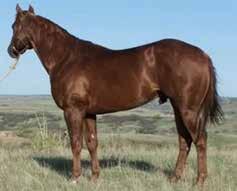
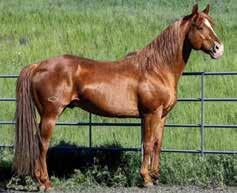
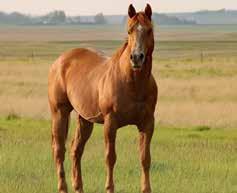

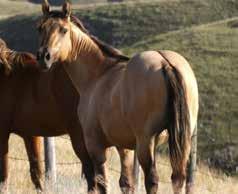
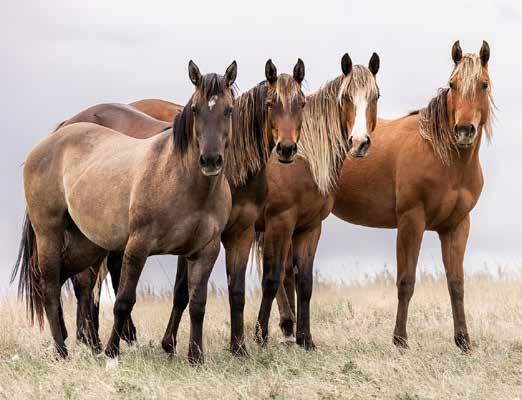

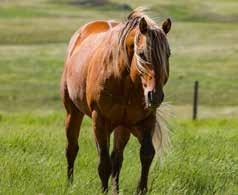








The First Lady of Reining and the cheers heard round the world.
BY MONIQUE NOBLE
he reining world was left spinning on December 7, 2024, as reining royalty two-legged and four competed at the world’s richest reining competition, with +three million dollars in total prize money! At the National Reining Horse Association (NRHA) event, elite three-year-old horses and their riders vie for their chance to win the Level 4 Open paycheck of $350,000.
As the only woman in the Level 4 Open class finals flew into
the arena on Saturday night – from the huge first stop and the electric back up – the crowd went wild, knowing they were witnessing history in the making. Beneath the roaring stands, Kaci O’Rourke and her mount, a three-year-old stallion named The Firemen (Inferno Sixty Six x Redhot Walla x Walla Walla Whiz,) exhibited grace, speed and years of hard work. As each manoeuvre, rundown and stop grew stronger, their connection was palpable and the roar of the crowd was deafening. When the duo’s 229 score was finally announced, the fans packed in
the Jim Norick Coliseum (Oklahoma City, Oklahoma,) were erupting. The crowd jumped to their feet in exuberance. Kaci O’Rourke had become the first woman to win the NRHA Futurity Level 4 Open and buried her joyful tears into The Firemen’s luxuriant forelock as she embraced him in gratitude.
A few weeks after O’Rourke’s incredible ride, WHR was able to catch up and talk with her. Here’s what she had to say about the amazing experience and journey to the futurity.

I’M SO THANKFUL THAT GOD PLACED HIM [THE FIREMEN] IN MY LIFE BECAUSE HE’S INCREDIBLE,
After such an incredible performance, it’s no wonder O’Rourke hasn’t yet had a chance to catch her breath.
“I mean, the last two weeks have been very crazy. It’s been wonderful. But you know, of course we’re jumping right back into starting our yearlings and riding two-year-olds and still looking at horses or selling horses. Everything still moves on.”
The carousel of work and reward with horses does not stop, but the joy O’Rourke takes in her work is clear.
“Yeah, the carousel does not stop, does it?,” she chuckles. “And you know, I don’t want it to, it’s great. But no, I haven’t caught my breath.”
Horses have been taking O’Rourke’s breath away since long before she could walk. Originally from Vermont, O’Rourke originates from the family business of Pond Hill Farm – the largest working horse ranch in New England. Pond Hill Farm has horses of all kinds and O’Rourke grew up riding all of them. O’Rourke’s family has supported her dreams from a young age, but it was one horse that helped find her calling.
“I was around 12, my dad got in a three-year old gelding that was reining trained and it was just the coolest and I fell in love right away. I love the obedience you know; they are so broke. I mean you could hop on and do anything and the other thing that’s always attracted me to reining horses is that even if they’re not a top reining horse, they adapt so well into other disciplines. They could find a good home anywhere.”
By the time O’Rourke was 18, she knew reining was her future. Determined to learn from the best, she left home and started working professionally with reining legends Casey Deary and Craig Schmersal. Her admiration for and gratitude for the opportunity to work with elite professionals is apparent.
“My goal was to learn from the very best and experience that top level of the sport. I think that’s definitely what got me hooked on the futurity, derby horses and aged events… definitely, it taught me a lot about what to aspire to and got me around some really great people and great horses. It taught me to what a great horse should be,” she relays.
Finding the loves of her life through reining O’Rourke also met her husband, business partner and fellow reining trainer, Jack Daniels, while working as a trainer’s assistant. The two
talented trainers struck out on their own and started Pond Hill Performance Horses, an eponymous homage to her family ranch in Vermont. While both Kaci and Jack admire The Firemen (who is known around the barn as “Thiago,”) it was Jack who started him and first believed in his abilities.
“He [Thiago]was so athletic and reactive and of course, when you’re on a horse and used to riding him, Jack knew the special ‘feel’ Thiago had. Around September, Jack had too many horses to ride one day and just told me that I could get on him and lope him around. And I mean, Thiago’s got an incredible feel! Not only is he so reactive and athletic and attentive, but you also just love being around him. He’s so smooth, he’s so quiet and he’s so enjoyable. Just to lope around on him – but then when you ask him to do something, it’s like turning on the boosters. It’s cool. It’s such a cool feeling,” she states.
From then on, Thiago became Kaci’s mount. In other words, it could be implied that she stole the horse from her husband.
“Yeah, I did yeah, Jack never got him back, he doesn’t let me live that down,” Kaci laughs.
Despite losing his horse to his wife, Jack is Kaci’s biggest supporter and literally brought the house down while he was cheering on her historic ride. The sign he was thumping on had to be rehung after his enthusiastic ringside support. Kaci is quick to mention it’s the people supporting her that make this type of show possible, as there is so much work and care behind the scenes. O’Rourke makes a point of staying quiet and focused before her run. Her team allows her to do so while maintaining the work that needs to be done.
“It is challenging because you also have a business to run – even while the finals are going on. You’ve got sales going on, you’ve got customers at the stalls, you’ve got people to talk to. There’s a lot.
“I try to find time to just be quiet and will get to point where I kind of avoid too much busyness if I can. This year it was pretty busy around the stalls the whole three days leading up to the finals.”
While not visiting with potential clients, Kaci, Jack, their team of assistants and care workers take great pride in keeping their equine athletes comfortable and in shape. They want them to perform both physically and mentally. Each horse has their own

nutritional needs and they are ridden and iced every day.
“We kind of go all out. We have our massage lady, Katie Sarita, who does the chiropractic work on the horses that are in the big events. She’ll check them daily. We have a Bemer, a laser, and shockwave therapy (ST). Horses were getting ST every two to three days and they get lasered every day, sometimes twice a day. We use the Bemer before we ride and then they get the follow up water spa after we ride. The whole show is intense. Our vet came up three times just to see our horses as well. We do literally everything you could think of to care for our equines,” O’Rourke explains.
When you don’t see what’s going behind the scenes, it’s easy to miss the amount of work required to keep Jack and Kaci’s equine
athletes prepped.
“It’s important to have a whole team behind you, thinking of everything. My husband shoes all our horses. He checks the sliders to make sure they’re not loose. Horses are going to the spa. We have a great team of assistants helping our horses get magic cushion in their foot wraps, poulticed and on a feed schedule,” the professional admits.
“There is so much going into the care side and I would say that’s even more important than the training side of it.”
Beyond the daily physical maintenance of the horses, the Pond Hill team knows the importance of keeping their athletes mentally at ease, so they frequently go out for rides to keep the horse’s limber. Kaci rode Thiago a few times without spurs outside of the
competition to keep the pressure off. A beautiful mover, Thiago has immense arena presence and while he is very quiet-minded, he is also quick to react. While some might interpret that as being a little “hot,” O’Rourke emphatically points out that Thiago is not and is instead, a “quick thinker.”
“He definitely has a lot of feel. If you put him on cruise mode and he is just loping around, he’s really quiet. When you ask him to do something, you’re going to get a lot, absolutely. I definitely wouldn’t classify him as being hot, or even forward. He’s not a forward horse, but he’s very reactive. You merely need to whisper to him, not shout. Thiago is a very, very responsive horse.”
Thiago’s attentiveness to his rider paid off in huge dividends, via subtle ways as he and Kaci performed their winning run. In tune to every movement of his rider’s body, the horse responded to the slightest increase or decrease or pressure throughout the run. This assured O’Rourke that he was “with” her and focused. He was ready to shoot for the win. When asked how she checks in with her horses while competing, she says it all comes down to subtlety.
“Even in my circles, if I quit pushing for a second he quits accelerating from it. And that’s what I want to feel. If I give him a very subtle change, relax a little bit with my feet or quit pushing he comes back to me like, ‘Okay, are you still telling me to do this?’” O’Rourke illustrates.
Thiago’s connection with Kaci gave her the confidence to seem fearless in the showpen and feel prepared for the run ahead of them.
“I try to stay really relaxed and confident in my horse. I think about just being really, really prepared. I try to think through every situation, so nothing surprises me. I try to just take the runs, maneuver by maneuver and break it down and not let it overwhelm me, or come at me too fast. I try to slow everything down in there.”
O’Rourke says that her mental preparation before a run helps her a great deal. When it came time for the Finals run, she says she felt very calm and a lot confidence in The Firemen. Preparation is a key component to Kaci and Thiago’s success, but it didn’t happen overnight. While Thiago has a wealth of natural athleticism, it was consistent training and a variety of different training drills that created a foundation for greatness. Case in point was the incredible back-up the pair displayed after their finals run in – which first got the crowd roaring at the edge of their seats.
“Thiago is obviously a very natural athlete. But we do several exercises. I think it a lot of comes down to foundation stuff. For example, willingness, being able to draw on your horse’s face, being able to pull on the bridle and have their feet move without resistance. That’s a huge part of it. That’s what we spend our whole two-year-old year working on. A lot of times if you have that good foundation you can get a feel – especially when you’re backing up that fast – of how much you can ask of them without them stepping on themselves or messing up. I think teaching those two-year-olds aspects like awareness of their feet and how to take direction without resistance is the whole thing. That foundation is important, so when you do ask for speed, you can do so with confidence.”
Winning the Level 4 Open is an accomplishment for anyone, but O’Rourke made history when her 229 score was the highest of the night and she became the first woman ever to win the

about it.
“It’s definitely a dream come true! It’s a surreal experience. We came home from the Futurity and Jack and I were both like, “Okay, let’s go start the yearlings. Let’s go work on the two-yearolds. I’m trying to soak it in as much as I can, but we’re both very forward-leaning people. We definitely don’t wanna sit back and rest.There’s a lot more to do and we’re energized and ready for it.
“What we did, I mean, I think it’s an amazing experience. But I don’t wanna quit there,” O’Rourke states.
The excitement of Kaci’s win has sent a ripple effect throughout the reining community, in a way never seen before. The day after her historic run, social media platforms blew up with infectious momentum. Women across the globe were inspired to ride, to work on their back ups, and to go out and just DO IT.
“The fact that I’ve been able to inspire anybody – that means a lot. I hope people don’t hesitate to reach out or ask questions. All that stuff means a lot to us and I’m so thankful for the crowd, my husband, my family and my owners, Peter and Courtney Morgan and our entire team.”
Kaci O’Rourke and The Firemen are both the first and last champions to walk through the iconic Gateway of Champions, before the doors of an arena that has hosted some of reining’s brightest moments close for the last time. After six decades of serving Oklahoma City and the NRHA well, the Jim Norick Coliseum will be demolished and give way to the brand new OKC Coliseum.
Kaci O’Rourke will return to the NRHA Futurity, in the new building. Her advice to all riders, regardless of gender? Stay true to yourself and if you want something, be willing to work for it. Stick to your dreams and it will come.

A retreat centre and Bed & Breakfast, located in the rolling foothills of Longview, AB.
BY JENN WEBSTER
At the Cowhorse Ranch, guests can experience a tranquil sanctuary that is only a short drive away from the concrete jungle. Nestled into the Foothills of Alberta, Cowhorse Ranch combines rustic ranch vibes with cowboy chic in its fully restored cabin home. Bringing the “Old West” to life, the main accommodations feature a log exterior and cabin-like features on the outside. The inside of the iconic ranch-style home focuses on raw wood elements, textural fabrics and a sprawling layout. With four bedrooms all equipped with king or queen beds, this place is the perfect spot to host a family getaway or a corporate retreat, enjoy mountain views and enjoy the serenity of the western lifestyle.

Traditionally, ranch-style homes have large windows and an open floor plan. The Cowhorse Ranch is no exception. Bridging the gap between indoor and outdoor living, this retreat features numerous large windows to allow as much natural sunlight inside as possible. The expansive breakfast nook for example is done almost entirely in floor-to-ceiling windows, providing a breathtaking view of the ranch’s pastures beyond. Besides that, the breakfast nook also directly connects the living space to the outdoors with a door that opens to the patio.
Additionally, high sloping roof lines throughout the home and its neutral color palette make for an easy flow between rooms. Windows and skylights can be found above eye-level, allowing even more natural light in and adding to the home’s visual appeal. Ranch-style homes became popular after World War II but they are still as appealing as ever, often for their open spaces, large windows and increased energy efficiency: so many windows prevent the use of unnecessary electricity for light.
Previous to becoming the Cowhorse Ranch, this property was a hub of activity for the Alberta team roping world. Its current owners, Dean Ness and Michelle Wind want to reclaim the land’s heritage as an equine facility while also offering it to the public as a western retreat. With pops of western art and artifacts at every turn, the accommodations here are brimming with history. The Cowhorse Ranch recently played host to the Traditional Cowboy Arts Association Annual General Meeting, with guests traveling from as far away as Argentina. Future plans include refurbishing the riding arena to support cow horse related activities such as roping and cutting, in addition to equine-themed personal development retreats.






Simple architecture and design details are another characteristic of a ranch home. Upon walking through the front entry way, the expansive ceilings with exposed beams, hardwood flooring and open space concept immediately catches your attention. Next, one is drawn to the wall art and historical artifacts housed in their own display spaces with individual lighting. Paying homage to Wind’s Métis background in one of these nooks is a handcrafted leather coat that once belonged to her mother. There is also a saddle tree with hand-braided romal reins in a second nook and a bridle in a third – all of which add to the authenticity of the retreat.
Forward takes you up a wide staircase to the second level. (We’ll get to that in a bit…) But an immediate left turn takes you to the sunroom / breakfast nook and a spacious chef’s kitchen – and we’re not just talking about that term loosely used in the real estate world to define a cooking space that has higher-end appliances and storage features. The kitchen at Cowhorse Ranch has a large island with a marble top, that came from Argentina. Granite countertops in every direction provide ample space for food prep and clean-up. There are many drawers and cupboards, for efficient organization of ingredients and cookware. A dishwasher, stove-top, oven, microwave, coffee maker and shelving unit for wine meld functionality, aesthetics with modern conveniences for guests on-the-go. Therefore, if you want to cook at the Cowhorse Ranch, you will have all the space and amenities to do so. If you’re someone who loves to cook – once you realize all the opportunities this place extends – you’ll probably never want to leave!
Anyone who needs to quickly get caught up on emails can use the kitchen alcove, with its built-in desk. Located off the kitchen is a sitting room divided by a fireplace, to the dining room. Adorned with a beautiful chandelier and a long table, the dining room has its own wide-open windows. Here, there is much territory to congregate and communicate after a good meal.
Immediately to the right of the front entrance is a hall that takes one to the office and media room. Here, there is also a full bathroom for guests who might stay in this part of the home. The media room can double as a sleeping area with its pullout couch, or simply as a place for families to wind down with a movie after a long day. A beautiful tiled fire place is centred in this room, adding to its coziness.
Further down the hall – which is lined with life-size photos of the owners’ horses – is the office on the left. Equipped with a queen Murphy bed, this room can provide a place to get corporate errands done or become another designated space for guest quarters – meaning the Cowhorse Ranch can sleep up to 12 people. The art of Shannon Lawlor adorns the walls here and burgundy wood cabinets complement the leather tones of the furniture.
Directly across the hall from the office is an enormous laundry / mudroom with its own half-bathroom. And at the end of the hall is an opening to the patio area that features
the outdoor hot tub – the ideal space to wind down and rejuvenate after a long day. An exterior door from the hot tub area leads into an indoor room where there is also a sauna and a shower.
Also on the main floor and tucked off neatly to the side of the dining room is the master bedroom. This room boasts a king bed, sitting area and fire place. Double patio doors look out over the ranch’s tranquil pond, as does the large jet tub of the master ensuite. A tiled shower is visible from the bedroom, via its clear glass block wall design. Inside the primary ensuite is a regal wood vanity that extends up the wall, offering his and her sinks, marble counter tops and a number of drawers for toiletries. Of course, the primary bedroom is also equipped with a large, walk-in California closet for guests who may be travelling with a lot of clothing or planning a fashion shoot at the location.
It is often said the distinctive qualities of a ranch house means it doesn’t include a second level. However, in Canada, nothing could be further from the truth. Split-level homes became popular in our country in the 1950s as a solution to the problem of increasing floor space, without requiring wider lots. Obviously, that wasn’t as much of a problem for rural homes, but it’s nice to have the master bedroom or other bedrooms on an upper level, to offer privacy for guests. Every bedroom in the Cowhorse Ranch offers an expansive view of the property – and no more so than the rooms in the upper level.
Once again, the accommodations upstairs meld rustic elegance with luxury and comfort. Immediately situated at the top of the staircase is an open loft and sitting area with a coffee bar. Off to each side are bedrooms. One features a king-sized bed with a window reading nook. The other room is furnished with two queen, sleigh beds and another window nook. Each bedroom is kitted out with fluffy, white duvets and pillows galore. There is a shared full-bath on this level with a large shower, skylights and a free-standing, porcelain sink.
With all its unexpected comforts, private spaces and quietness of the area, the Cowhorse Ranch delivers a serenity like no other. Enjoy a fire on the outdoor entertainment patio, barbecue some steaks or simply partake in stargazing at night. Leave the hustle and bustle of city life behind and unwind with only the sounds of frogs and birds (or maybe the odd horse “whinny”) to soothe you. Go for a hike. Meditate. Get a suntan, or simply enjoy a staycation with family in this serene escape. The rugged charm of this retreat is something you’ll never forget.
For more information about the Cowhorse Ranch, email: cowhorse.ranchretreat@gmail.com




Clothing that works as hard as you do!
All outfits provided by Lammle’s Western Wear.

opposite page: Ariat Men’s Rebar Cloud 9 insulated vest
$150. CINCH plaid long sleeve button-down shirt in white $115. Wrangler 20X - 01 Competition jeans, River Wash $85. Hat and boots are model’s own.
this page: Hooey Brands Rodeo cap $55. Kimes Ranch Women’s Two Scoops hoodie in rust $140. Earrings are model’s own.
on her: Hooey Brands Rodeo cap
$55. Kimes Ranch Women’s Two Scoops hoodie in rust $140. Kimes Ranch jeans, Sarah High Rise straight leg $190. Ariat Women’s Buckeye waterproof shoes $160.

on him: Kimes Ranch Men’s Diamond Head 1/4 zip hoodie $140. Wrangler 20X - 01 Competition jeans, River Wash $85. Ariat Men’s Buckeye waterproof shoes $165. Hooey Brands Men’s CRO84 cap $55.



CINCH plaid long sleeve button-down shirt in white $115. Wrangler 20X - 01 Competition jeans, River Wash $85. Hat, belt and boots are model’s own.




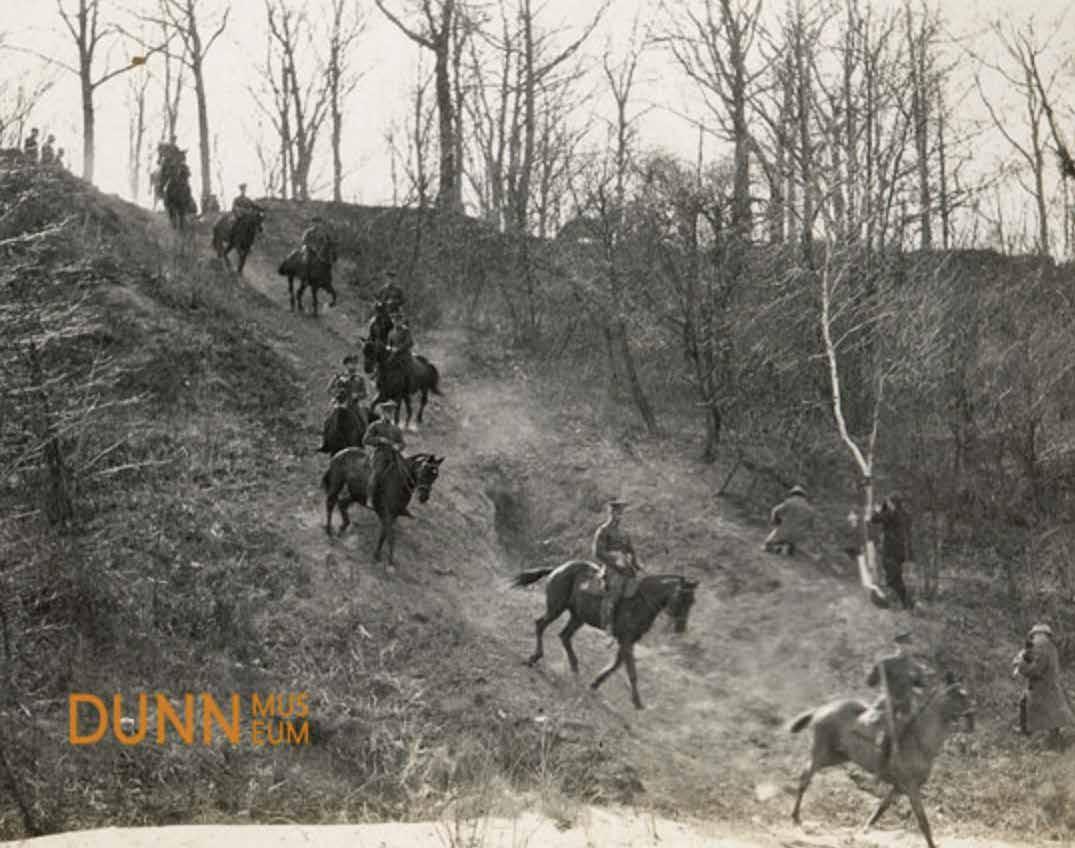
With the bar set at eight-feet-and-three inches, Great Heart established a high jumping record which has yet to be broken.
BY DEBBIE MACRAE
Achievement is often born out of necessity. It is the effort put forward that sometimes culminates in an unexpected success, not the need for it. Such is athleticism.
Physical qualities such as strength, agility and endurance collectively demonstrate athleticism in a horse. Yet, it is the animal’s “heart” – the willingness and drive to compete – that makes the difference.
From the earliest writings of Athenian soldier and historian, Xenophon, with his emphasis on care and training of horses,
the achievement of success hinged on the willing participation of the equine athlete. Advanced training methods included cavalry exercises and military training for the war-horse, each of which developed different skill sets and endurance for battle.
These elements of horsemanship and competition were defined in Xenophon’s works written approximately 355 B.C. and from these, centuries later, evolved the successes of the equine athlete – the modern soldier – at the height of their careers.
THIS PAGE: Cavalry rough rider, circa 1930. Onlookers are so close they could almost reach out and touch the horses! BBDM 92.24.251.1

What started as a peaceful demonstration for an eight-hour work-day, culminated in what became known as the Haymarket Massacre on May 4, 1886 at a plant owned by the McCormick Harvesting Machine Company on the south side of Chicago, Illinois, USA. Workers rallying for a reduced workday were caught in the crossfire after someone threw a makeshift bomb at police, trying to break up the demonstration. Seven members of the police force were killed; four civilians, and numerous others wounded. It became the pinnacle of the unrest in the working-class people of America after the Civil War and the Long Depression.
The Commercial Club of Chicago became focused on the need for a military garrison to quell the labour unrest. They arranged for a donation of land, which would ultimately become the home of Camp Highwood. Troops arrived in November of 1887, and the foundation of Fort Sheridan was formed.
Fort Sheridan was named after General Phillip Sheridan, one of the Civil War’s most successful cavalry officers. In the years following that war, many believed the cavalry had outlived its usefulness. However, General Sheridan believed that cavalry training had significant meaning and purpose and worked

diligently to ensure that modern horse soldiers were trained as efficiently in the saddle as they were on the ground.
Sheridan provided the optimum training ground because
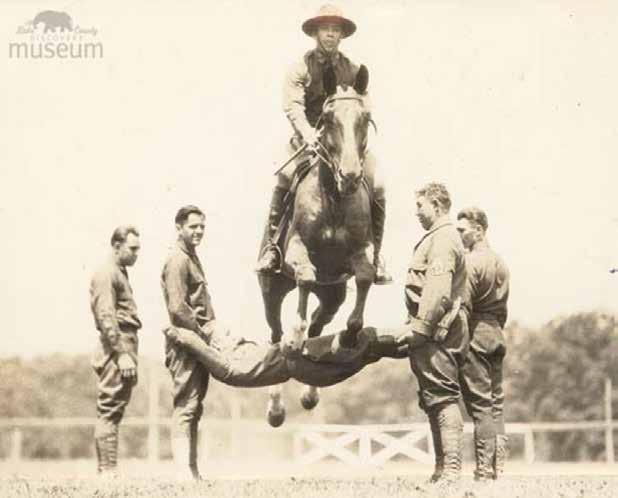
of its geographic location and diverse terrain. Overlooking Lake Michigan, the area was forested, with steep bluffs leading down to the sandy lakeshore. On land or in the water, strengthening and endurance was a natural consequence of their activities, and their athletic prowess progressed daily.
By 1925, Fort Sheridan commenced a public relations program in conjunction with their military training. Polo matches and horse shows, jumping competitions and publicity stunts brought public acclaim and the property developed a country club ambiance after the end of World War I.
It was a period of rapid economic growth, especially in the north and western states, and the accumulation of wealth led to ostentatious competitions of showmanship and competition. With their rigorous training and country club atmosphere, natural talents began to surface.
One such talent was a young hackney horse cross owned by Francis Stuyvesant Peabody, a wealthy Chicago coal baron, who established his fortune in the coal fields of Illinois.
Originally slated to follow in his father’s footsteps as an attorney, Peabody turned his sights to banking, with an eye for opportunity. At the age of 24, with an investment of only $100, he found it, purchasing and selling coal as a retail coal vendor.
He founded the company Peabody, Daniels and Company, in 1883, and bought out his partner’s shares six years later. By 1905, he was the president of ten companies, and during World War I, he became the chairman of the Coal Production Committee of the Council of National Defense. By 1920, his firm had become one of the largest coal companies in America.
As Mr. Peabody gained in prosperity, his interests diversified in keeping with the status of the elite. He was the impetus behind the creation of the Chicago District Golf Association.
He constructed his personal estate at Mayslake (named after his wife and his daughter), at Oakbrook, Illinois, including grounds for fox hunting. Also embracing the sport of horse racing, he started a collection of Thoroughbreds, and from that collection evolved the hackney horse cross, known as Great Heart. Purchased as a young colt, Great Heart had a huge affinity for jumping – especially six feet and over.
In keeping with the elite competitions of the early 20th century, horse shows were held annually in the Chicago area at Onwentsia, Soldier Field, the South Shore Country Club and Fort Sheridan. Polo games and high jumping were integral competitions for the shows.
Great Heart participated in 1922, at the South Shore


Country Club horse show, clearing the high jump bar at sevenand-a-half feet, winning a championship, but failing to beat the world record. At that time, the record was holding at eight-feetand-one-half inch, set in 1910 in Ontario, by a horse named Confidense. Another horse, by the name of Strongheart, won the high jump championship at the International Horse Show in Chicago, in 1922, with the bars set at five-feet six inches.
Then in 1922, Mr. Peabody died during the first fox hunt of the season. Starting out with his wife, and several friends and associates, he would later be found, having dismounted his favorite horse, Dunbar, beside a small lake on his estate. Dunbar never left his side.
From that point forward, Peabody’s son, Stuyvesant “Jack” Peabody, continued training and jumping Great Heart. Once again, in 1923, Jack entered Great Heart in the South Shore Country Club’s show jumping challenge, determined to win and break the world record.
With a bar set at eight-feet-and-three inches, Great Heart established a record which has yet to be broken. To this day, Great Heart’s achievement continues to elude the lenses of history, who have failed to recognize that record. Instead, the honour has gone to Huaso ex-Faithfull, at the Official International Event at Viña del Mar, Chile, on 5 February 1949. His height record was eight-feet-one-inch – two inches less than Great Heart.
Great Heart was retired to the Peabody farm, and shortly thereafter, was honoured in 1924 by his family, who chose the name “Great Heart,” for the finest grade of their coal produced at Peabody Mine 30, at Kenvir, Kentucky.



The young blue heeler was eager to please. So willing to do as his owner asked – so keen to display his strong herding instincts.
Things had been going well over the last few days. He had accompanied the old rancher out to the cow pasture several times and was beginning to learn the basics.
“Lie Down!” and “Walk up!” were becoming fairly consistent cues, as the Heeler unfolded his herding instincts. “Away to Me!” and “Come by” weren’t yet as solid. Still, the old rancher was pleased with the dog’s progress and expressed his gratitude by rewarding him at even the smallest victory.
“Good boy!” was what the dog craved, knowing he had done something correct to assist in the moving of the cattle.
So one day, when a group of cantankerous Longhorns needed to be moved from the front pasture into the back, the old rancher figured it would be a quick and simple job. He’d take his dog and have his assistant on a quad. The rancher would be on foot and between the three of them, they’d get the Longhorns to where they needed to go. Scoop them up from the bottom field, direct them to the gate, move them along easily through the yard and funnel them through the open back panel gate into the new pasture. Easy peasy.
Having not ever witnessed the Heeler at work, the old rancher’s wife came out to watch. And low and behold! She was astonished at

By Bronco Betty
how well the dog was obeying her husband’s commands. The wife stood in the trees, so as not to get in the way of the moving herd. She knew better than to catch their eye or block the herd’s way through to the back.
Her husband yelled something to the dog. In response the dog stopped moving forward and ran around to one side of the herd.
“WOW! What a good boy!” she hollered to the Heeler.
The old rancher was confused – the dog was correct in realizing he had to move to one side of the cattle, but he had put himself between the herd and the out gate of the front pasture.
“Come by!” The rancher cued the dog, in an attempt to bring him clockwise around the herd and back into a driving position. This wasn’t the strongest of the Heeler’s commands, so instead the dog guessed and layed down on the spot.
“Yeah! Good boy!!” The wife squealed.
“What in the hell…?” The rancher cursed under his breath. His hearing wasn’t as good as it once was and he hadn’t seen his wife sneak into the trees either. The cattle stopped in their tracks and did a complete 180. They were now moving back on to the rancher.
“Come here!!” the rancher sputtered in desperation.
This time the Heeler did exactly as he asked, right through the centre of the longhorns. The cattle split off in every direction as the dog


happily bounded back to the rancher. That’s when a baby blue coat became visible to the rancher in the trees.
“Darling! Are you out here?” He called over to his wife.
“Yes, I’m here! I can’t believe what a great job you’ve done with the dog,” she hollered back, as she stepped out into the sunlight.
“Yes, well, we still have some things to work on,” the rancher replied. “But right now, our dog needs a treat. Do you think you could go back into the house to grab him one?”
“Oh yes for sure!” his wife happily agreed. With that, the baby blue coat made her way back to the house.
The assistant on the quad had used this time to circle the Longhorns back together.
“Walk up!” The rancher cued the dog. And while the wife searched the house for dog treats, the cattle swiftly moved through the out gate, across the yard and into the back pasture – with the dog right on their heels. As the rancher was swinging the back pasture closed, his wife ran up to them all, out of breath and treat in hand.
“Did I miss it?” she asked with an air of disappointment.
“Nope Darling, you’re right on time with that treat,” the rancher said. And just as he ducked under the barbed wire fence back to his humans, the dog was greeted by the baby blue coat and a cookie.








